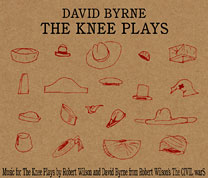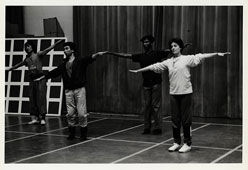THE ALBUM

- ESSAY
- TRACKS, LYRICS, & AUDIO
- CURRENT REVIEWS
- LIVE DATES (COMING SOON)
- CREDITS
- BUY CD (AMAZON.com)
- DOWNLOAD (COMING SOON)
WHAT’S A KNEE PLAY
Meanwhile, I had decided that the Kabuki percussion idea wasn’t so perfect after all. I remembered hearing the Dirty Dozen Brass Band at a place called The Glass House in New Orleans a while back, and I thought they would certainly be loud enough to drown out backstage noise, and their funky riffing and incredible feel would be an unexpected yet mesmerizing juxtaposition to Bob’s usually cool stage pictures. They’re no strangers to repetition, which might complement the incremental changes in Bob’s staging, but they’re also funky as hell, which would be a bit of a wild card. So I contacted them, and before going to New Orleans I wrote a bunch of pieces and had some traditional gospel and folk tunes scored for them. I had a great time in New Orleans—it’s hard not to—but musically it was not happening. Despite being great musicians and playing a wide variety of material, from Monk to Second Line to TV themes like “Wild Wild West!” being strapped into the scores was not a comfortable or creative place for them. I moved on and hired local musicians in Minneapolis for that stage of the piece.
Auditions for the performers were set up in New York. They were a motley bunch: some had worked with Bob before, while others had backgrounds in dance or downtown theater. There was a variety of body types and sizes too, a welcome change for a “dance” production. In fact, anyone who was “balletic” or “dancerly” was immediately disqualified.
The Rome Section opening of the CIVIL warS was delayed due to strikes and as a result Bob could not be in Minneapolis in time for the initial rehearsals. Suzushi and Adelle ran the workshop in his absence, during which the dancers simply studied Kabuki dance exercises over and over, honing their movements and becoming a unit. The performers had nothing but admiration for soft-spoken Suzushi—maybe twice the age of many, she had more stamina and endurance than any of them.
I arrived and we began to sketch out on stage how each of Bob’s narrative instructions could be realized. In Einstein on the Beach everyone wore thrift store outfits, suspenders, and sneakers, so I assumed low budget costumes might be OK for this production too, but maybe not for the large acts. We ordered a bunch of lab coats from a scientific catalogue, which complemented the white cubes and the minimal staging pretty well—dancing scientists, sort of. Bob arrived and he began to think about lighting—his lighting is amazing. In this case he hid strips of neon on dimmers behind a small barrier upstage. It created a very even and unearthly glow on the upstage scrim.
Bob also added white face paint to the dancers with bright red mouths— Kabuki? Chaplin? Vaudeville? Weimar Cabaret? The movements in the exercises were so stunning and modern looking that Bob used many of them in mini-Knee plays linking together the main Knee plays. Suzushi joined the production as a performer, and Knee Play 10, “Winter,” was essentially a solo for her. She transposed elements of a traditional dance into a completely nontraditional context and the result was something deeply sad, strange, moving, and arresting.
Again inspired by Einstein and other productions of Bob’s I’d seen, I began to write text pieces that could be recited over the pieces I’d written for a brass band. None of these was directly related to Bob’s “story” and they were certainly unrelated to the stage action. But I realized that things that happen simultaneously are often presumed by the mind and heart to be related in some way. This serendipitous chance structure may have come from a line stretching back to the Surrealists or the Dada poets, or from Cage and Cunningham (very likely the latter, in Bob’s case). Their argument was often that nature, life, the world, all work this way—wildly disparate things happen simultaneously and we presume that connections exist. Intentionality is merely a concept we construct. Therefore, to “illustrate” things that are happening on stage with music or text is redundant. When you look up at clouds in the city, and the sound you hear is hip hop and traffic noises, well, that’s the score for the cloud image—you just accept it. So why not accept similar connections on stage? When it worked it added a resonance and a crazy wider meaning to the whole thing. When it didn’t work it just seemed like nutty artsy-fartsy stuff.
